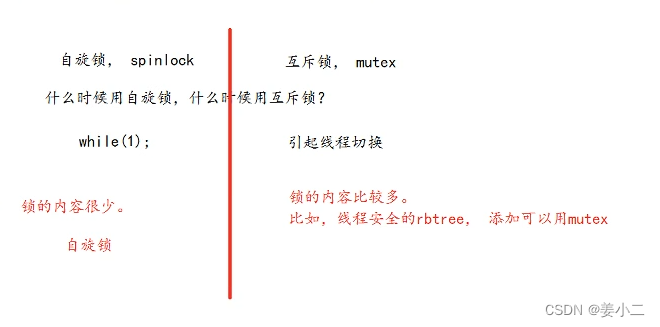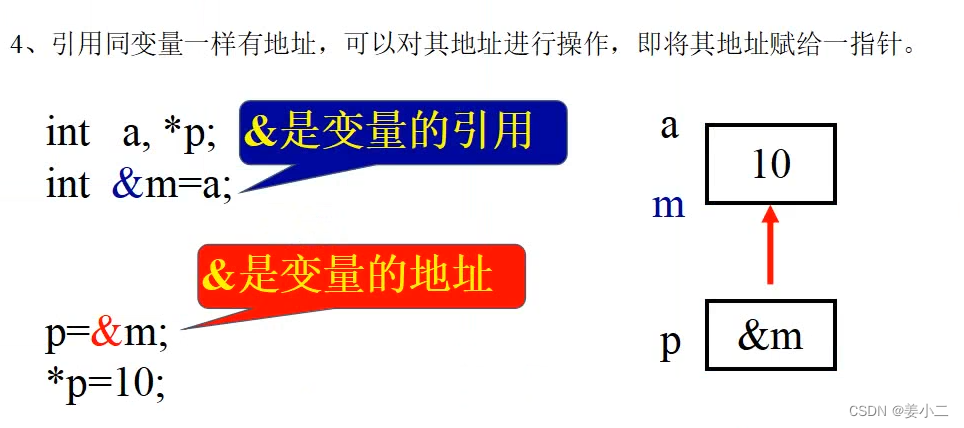- fprintf、sprintf 函数的作用,如下图代码所示:
fprintf(fp, "name: %s, phone: %s\n", "hello","world"); //fp是一个打开的文件指针,既把数据写到文件中
sprintf(buf, "name: %s, phone: %s\n", "hello","world");//buf是一个打开的字符数组,既把数据写到数组中
printf("%s\r\n,"hello"); //这个都懂,就不说了
2)在linux线程安全的时候,何时用自旋锁,何时用互斥锁,如下图所示:

从上图可知,如果需要锁的内容比较少的话,如 count++,则使用自旋锁,这样可以减少线程切换(以为线程的切换代价远远大于自旋锁的等待时间);
如果需要锁的内容比较多的话,如排序、列表插入等,需要互斥锁更好;
3)线程池的作用
1.避免线程太多,使得内存耗尽;
2.避免创建与销毁线程所带来的代价;
线程池三要素:任务队列,执行队列,管理组件;
4)链表的插入和删除,用宏定义实现,以后可以直接使用,代码如下:
#define LIST_INSERT(item, list) do { \
item->prev = NULL; \
item->next = list; \
if ((list) != NULL) (list)->prev = item; \
(list) = item; \
} while(0)
#define LIST_REMOVE(item, list) do { \
if (item->prev != NULL) item->prev->next = item->next; \
if (item->next != NULL) item->next->prev = item->prev; \
if (list == item) list = item->next; \
item->prev = item->next = NULL; \
} while(0)
- setw函数的使用,需要包含iomanip这个头文件;
说明:setw函数是右对齐,如下代码:
cout << "Hello World!" <<setw(5) << "aaaa"<< endl;
测试效果,如下:

6)C++中引用变量的学习总结
1.引用地址的操作,如下图所示:

测试代码如下:
#include <iostream>
#include<iomanip>
using namespace std;
int main()
{
int a = 0;
int* ptr = NULL;
int& m = a;
ptr = &m; //把m的地址赋给p,相当于把a的地址赋给p
*ptr = 20;
cout<<a<<endl;
return 0;
}
2.可以用动态分配的内存空间初始化一个引用变量;
测试代码如下:
#include <iostream>
#include<iomanip>
using namespace std;
int main()
{
int& refp = *new int; //这个空间只有别名,但程序可以引用到 2)注意书写格式:“ *new ”
refp = 222;
cout<<refp<<endl;
delete& refp; //注意书写格式:“ delete& ”
return 0;
}
输出结果:
222
3.引用的作用:主要用作函数的参数和函数的返回值;
7)C++中,类的嵌套,代码如下:
#include <iostream>
using namespace std;
class CC1
{
public:
int x;
void Func();
class CC2
{
public: //必须写public,否则会编译出错
int x;
void Func();
}obj; //这个对象必须有,否则会编译错误;
//如果没有obj这个对象,需要 CC2 obj定义一个对象
};
void CC1::Func(){ x = 20; }
void CC1::CC2::Func(){ x = 10; }
int main()
{
CC1 c1;
c1.Func();
cout<<c1.x<<endl;
c1.obj.Func();
cout<<c1.obj.x<<endl;
return 0;
}
7)友元函数
友元函数的作用:主要是可以访问类的数据成员,提高了程序的运行效率;
在类中,访问限定对友元是不起作用的;
用法: 通常使用友元函数来取类的数据成员值,而不是修改;
测试代码如下:
#include <iostream>
using namespace std;
class Test
{
public:
Test(int x, int y)
{
this->x = x;
this->y = y;
}
friend int handle(const Test& obj); //友元函数的声明
private:
int x;
int y;
};
int handle(const Test& obj) //友元函数的实现
{
return obj.x + obj.y;
}
int main(void)
{
Test t1(2,3);
cout<<handle(t1)<<endl;
return 0;
}
8)友元类的代码案例
#include <iostream>
using namespace std;
class A
{
public:
A(int tma,int tmb) : aa(tma),bb(tmb){ }
friend class B; //A把B当朋友,B可以访问A的数据成员;(我把你当朋友,你可以访问我,但我不可以访问你)
private:
int aa;
int bb;
};
class B
{
public:
B(int tmp = 1) { mm = tmp; }
void handle(const A& obj)
{
cout<< obj.aa + obj.bb + mm <<endl;
}
private:
int mm;
};
int main(void)
{
A a(33,44);
B b(10);
b.handle(a); //打印A类和B类的数据成员之和
return 0;
}
输出结果:
87
9)new的使用
用new开辟的内存空间没有名字,指向其首地址的指针是使用其空间的唯一途径;
10)运算符重载相关代码案例
#include <iostream>
using namespace std;
class Test
{
public:
Test(int a = 0, int b = 0)
{
x = a;
y = b;
}
Test operator+(const Test& obj)
{
Test tmp;
tmp.x = this->x + obj.x;
tmp.y = this->y + obj.y;
return tmp;
}
int getX() { return x;}
int getY() { return y;}
private:
int x;
int y;
};
int main()
{
Test t1(4,10), t2(4,5);
Test ret = t1 + t2;
cout<<ret.getX()<<endl;
cout<<ret.getY()<<endl;
return 0;
}
输出结果:
8
15






















 7887
7887











 被折叠的 条评论
为什么被折叠?
被折叠的 条评论
为什么被折叠?








